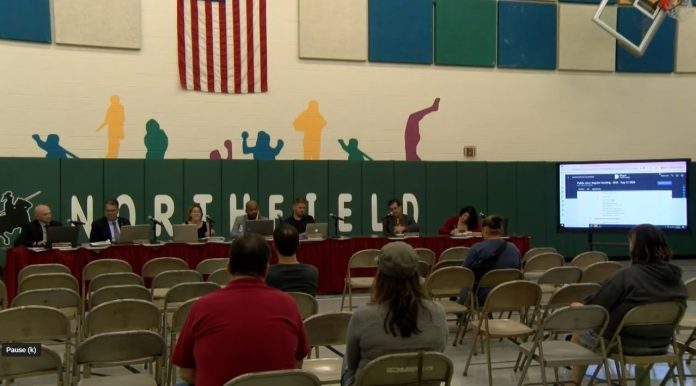Students and Staff Earn National Recognition
Nordonia High School showcased exceptional academic achievements at Monday’s board meeting, Principal Jesse Archer presented recognition for students who excelled on Advanced Placement exams and earned national honors.
The district administered 765 AP exams last spring, with 81% of students earning scores of three or higher – significantly above national averages. Students scored at or above national benchmarks in 17 of 27 subjects, producing an impressive 119 perfect scores of five. The school conducted home visits during summer to personally congratulate high-achieving students with “high fives.”
Notable Individual Achievements:
- 76 students earned at least one score of five on AP exams
- Five current seniors earned two perfect scores each
- Three additional students achieved three perfect scores each
Outstanding Faculty Performance:
- The physics department achieved remarkable success, with students earning a 100% pass rate on Physics 1 exams (compared to 73% nationally) and 86% on Physics 2 (compared to 78% nationally). The program covers both physics courses in a single year, unlike most schools that require two years.
- AP Seminar students posted a 98% pass rate with 43 participating students
- AP Biology students achieved 93% pass rate, well above the 71% national average
- AP Computer Science A students reached 90% pass rate, significantly higher than the 70% national benchmark
Superintendent Casey Wright praised the achievement levels, noting this represents the highest number of AP test-takers and high scorers he has witnessed in 28 years of education.
Career Center Excellence: Nordonia led all partner schools in early placement earnings through the Cuyahoga Valley Career Center, with 11 students earning state scores qualifying for national competition. Two students earned nationally ranked awards: one placed fourth nationally in education professions specializing in school leadership, completing an internship with the high school principal, while another earned fifth place nationally in both Java programming and web development. The programming student created an AI chatbot calculator for Java and developed a healthy habit app tracker for companies to use in health challenges.
Homecoming Court Recognition: The 2025 homecoming court was also recognized for representing positive student leadership. Selected by their peers, the court members are involved in various sports, clubs, and leadership positions. Principal Archer described them as “genuinely the sweetest, nicest kids” who exemplify respectful classmates and responsible teammates.
National Merit Recognition: Three students earned National Merit Scholarship Commended Scholar status, scoring in the top 4% nationwide on the PSAT.
Strategic Plan Shows Significant Progress
The board received comprehensive updates on the district’s “Achieve” and “Connect” strategic plan components during a work session, revealing extensive implementation efforts already underway.
Curriculum and Instruction Transformation: Curriculum Director Carol S. Tonsing reported meeting with every instructional team across the district to review the strategic plan and implement the five-step professional learning community process. The response has been enthusiastically positive, with the high school team meeting at 7 a.m. and requesting additional data support.
Teams are implementing high-quality student data analysis using state test results and diagnostic assessments. The middle school administered its first-ever Ohio Readiness Assessment, which serves as practice for state testing. Elementary representatives from each building observed the assessment to prepare for implementation.
The district has established vertical alignment for goal-setting, focusing on analysis skills where students show deficits. All content areas – including art, physical education, and music teachers – are participating in the data-driven approach.
Addressing Achievement Challenges: Officials acknowledged specific areas needing attention, particularly fifth-grade science scores and high school mathematics performance. The district scored a three in progress measurements on the state report card, which indicates expected growth but falls short of the four or five needed for a five-star district.
Despite increases in every indicator, including significant gains in seventh-grade reading (up seven points) and eighth-grade math (from 68% to 80% proficiency), the weighting changes in state measurements affected overall ratings.
The challenge involves moving proficient students to advanced levels rather than basic skill development. The district maintains its five-star rating overall but acknowledges the need for more intensive interventions to accelerate high-performing students.
Communications Revolution: The new Parent Square platform has achieved remarkable adoption rates, with 1,329 parents downloading the app from the district’s 3,500 families within the first month of implementation. Newsletter open rates reach 64%, indicating strong community engagement with school communications.
The communications coordinator reported establishing partnerships with over 20 community organizations, including Target, Walmart, Rotary Club, and State Farm, advancing toward the three-year goal of 100 community partners. The system now enables automatic translation of newsletters into multiple languages, eliminating previous delays waiting for translators.
Teachers received comprehensive Parent Square training during the September professional development day, with overwhelming positive response. Educators expressed readiness to utilize posts, newsletters, smart alerts, forms, surveys, and volunteer opportunity coordination through the platform.
The district is transitioning from traditional postcards to tri-fold informational pieces and planning quarterly pulse checks to assess communication effectiveness. Future initiatives include town hall meetings, enhanced community engagement events, and expanded recognition programs for students and community members.
Policy Updates Address State Requirements
The board approved second readings of multiple policy updates mandated by Ohio’s recent budget bill, covering areas including student discipline codes, electronic communication devices, career-technical education credit transfers, and budget planning procedures. These represent routine compliance updates rather than district-initiated changes.
Community Engagement and Safety Initiatives
The district highlighted successful community engagement through Safe Decisions Week, which concluded with the homecoming football game. The event featured mental health services information, impaired driving demonstrations with alcohol simulation goggles, and presentations from safety and law enforcement officials. Community members and students participated in educational activities while the Rotary Club provided complimentary hot dogs.
Unity Week continues throughout October, encouraging community members to donate canned goods and gently used items for local families in need.
Financial Management and Budget Planning
Treasurer Kyle Kiffer reported August revenues exceeded last year by $2.2 million, primarily due to tax collection timing and advance payments. The board approved fiscal 2026 permanent appropriations, concluding the three-month period for finalizing spending authority.
The treasurer presented an updated Popular Annual Financial Report, redesigned to provide clearer financial information to community members. The cash-basis report shows three years of revenue and expenditure data, property tax analysis, and district highlights. The 16-page document will be distributed to municipal buildings, the Macedonia Recreation Center, and local libraries rather than mailed due to cost considerations.
Key financial highlights include the district’s approaching conclusion of the MGM settlement, with a final $465,000 payment due in March 2026. Technology purchases have been shifted from July-August to June to provide more preparation time for the school year, contributing to different expenditure patterns compared to previous years.
The district continues using its five-year forecast as an active budgeting tool, aligning budget amendments with forecast projections rather than maintaining separate tracking systems.
Personnel Changes Reflect Growing Needs
The board approved numerous personnel moves, including new paraprofessional positions to support students with special needs. Superintendent Wright acknowledged the ongoing challenge of recruiting paraprofessionals, noting increased demand as students with Individual Education Plans require additional adult support.
Notable departures include a recent graduate who accepted a professional volleyball position in Europe and coaching position changes due to staff transitions. The district continues working to fill food service worker positions across multiple buildings.
Wright emphasized the district’s goal of not automatically replacing all positions, instead evaluating actual needs before filling vacancies.
Generous Community Support
Local donations totaled $3,200, including desk donations from a community member honoring her late educator husband, computer equipment for the high school, and supplies from Amazon and other businesses.
Foundation Success Doubles Impact
The Nordonia Hills Scholarship Granting Organization achieved remarkable growth, covering $222,000 in kindergarten tuition for 58 families – more than doubling last year’s $95,000 for 125 families. The organization provided full tuition coverage for 50 families, partial support for eight others, and $500 tuition reduction for every other district student.
Finance Committee Chair Chad Lahrmer noted the exponential growth, explaining that doubling again to over 500 donors next year could generate more than $400,000, potentially covering the entire kindergarten program and providing additional state funding to the district.
Legislative Concerns Impact Future Funding
Board members expressed significant concern about multiple House bills potentially impacting school funding. OSBA Legislative Liaison Liz McKinley detailed several problematic proposals:
House Bill 420 would eliminate all continuing levies after 2029, requiring periodic voter reauthorization. House Bill 421 would allow citizens to place inside millage reductions on ballots, affecting not just schools but municipal safety services. House Bill 422 would raise voter approval thresholds for new levies above 2 mills to a two-thirds majority.
Additional concerning legislation includes House Bill 335, which combines multiple proposals to remove districts’ ability to levy current inside millage, and House Bill 186, which would cap growth from the 20-mill floor to inflation rates, potentially creating funding gaps.
McKinley noted that while multiple bills could negatively impact district finances, no proposed legislation offers solutions to support adequate education funding in Ohio. She urged community members to contact state representatives and senators regarding these measures.
Some proposed bills received board support, including standardizing kindergarten entry age statewide and allowing schools to withhold student directory information from public records to protect minors from potential harassment.
Upcoming Events
The district will host its annual State of Schools presentation October 13 at 6 p.m., followed by the next regular board meeting October 20.
Discover more from Northeast Ohio News
Subscribe to get the latest posts sent to your email.










